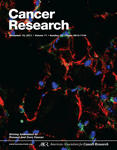来自弗吉尼亚联邦大学Massey癌症中心和VCU分子医学研究所的研究人员发现了多形性胶质母细胞瘤(GBM)促进神经元功能丧失或死亡也就是神经退行性变的一种机制,GBM是最常见的脑肿瘤。这一发现可能促使抑制GBM神经退行性变的新治疗方法应运而生,也可能用于其他神经退行性疾病。
这项研究最近发表在《癌症研究》杂志上,由Thelma Newmeyer Corman肿瘤研究主席Paul B.Fisher,M.博士主持。Fisher博士同时也是VCU Massey癌症分子遗传学项目的合作领导者,VCU医学院人类和分子遗传学系教授主席、VCU分子医学研究所主任。研究者发现,癌基因(导致癌症发生的基因)星形胶质细胞上调基因(AEG)-1通过增加谷氨酸的神经元毒性促进神经退行性变。谷氨酸在神经元之间的信号传输中发挥重要作用,对于学习和记忆也很重要。另一方面,谷氨酸可以在突触或神经元之间的间隙中聚集,通过过度刺激导致神经元死亡,也就是我们所知的兴奋毒性。
这项研究首次为GBM、神经退行性变和谷氨酸转运提供了直接机制,解释了GBM通过表达AEG-1癌基因引起神经元死亡的过程。AEG–1最初是由Fisher实验室克隆的,90%的脑肿瘤过表达AEG-1。
“胶质瘤是最常见的脑肿瘤,是20至39岁成年人癌症死亡的第二大原因,”Fisher说。“在强调AEG-1在脑肿瘤发生、发展和神经退行性疾病的重要性时,我们已经确定了通过干预治疗抑制上述过程的新靶点。”
Fisher的团队证实,AEG-1与兴奋性氨基酸转运体2(EEAT2)的表达呈负相关,EEAT2是大脑和脊髓胶质细胞(环绕神经元细胞,提供支持和隔离)主要的谷氨酸转运体。EEAT2对于保持突触部位适当的谷氨酸水平是必不可少的,无法调节谷氨酸水平将导致兴奋毒性。研究人员还发现,AEG-1抑制EEAT2的转录表达,也就是基因在细胞核中表达的过程,通过多种机制导致谷氨酸过量引起兴奋毒性。使用GBM患者样本,也证实了AEG-1的表达和神经毒性之间的这种关系。
“了解谷氨酸转运对于多种神经系统退行性疾病,包括脑胶质瘤诱导的神经退行性疾病、肌萎缩性侧索硬化症(ALS)、亨廷顿氏病、阿尔茨海默氏症、癫痫、脑缺血具有非常重要的意义,”Fisher说。“我们的实验室第一个克隆了EEAT2子,我们计划用它来筛选能够调节细胞外谷氨酸转运并防止神经退行性变的小分子或药物。”
下一步,Fisher和他的团队将努力构建先进的动物模型,进一步研究AEG-1的作用和谷氨酸在大脑发育中的作用和功能。一旦建立成功,这些模型也将有助于测试小分子筛选过程中所确定的药物。最终目标是利用本研究开发出治疗GBM和其他疾病所致神经退行性变的方法。
Fisher研究的合作作者:VCU Massey癌症中心VCU医学院人类和分子遗传学系VSU分子医学研究所Keetae Kim博士,Timothy P.Kegelman硕士,博士在读,Rupesh Dash博士,Swadesh K. Das博士,Luni Emdad,MBBS博士,EricL.Howlett博士,ZhaoZhong Su博士和Devanand Sarkar,MBBS博士。韩国汉城东方医学学院癌症预防材料开发研究中心李锡根博士,韩国江原道春川Hallym大学Ilsong生命科学研究所Dong-chul Kang博士。(生物探索)
相关英文论文摘要:
Oncogene AEG-1 Promotes Glioma-Induced Neurodegeneration by Increasing Glutamate Excitotoxicity
Aggressive tumor growth, diffuse tissue invasion, and neurodegeneration are hallmarks of malignant glioma. Although glutamate excitotoxicity is considered to play a key role in glioma-induced neurodegeneration, the mechanism(s) controlling this process is poorly understood. Astrocyte elevated gene-1 (AEG-1) is an oncogene that is overexpressed in several types of human cancers, including more than 90% of brain tumors. In addition, AEG-1 promotes gliomagenesis, particularly in the context of tumor growth and invasion, 2 primary characteristics of glioma. In the present study, we investigated the contribution of AEG-1 to glioma-induced neurodegeneration. Pearson correlation coefficient analysis in normal brain tissues and samples from glioma patients indicated a strong negative correlation between expression of AEG-1 and a primary glutamate transporter of astrocytes EAAT2. Gain- and loss-of-function studies in normal primary human fetal astrocytes and T98G glioblastoma multiforme cells revealed that AEG-1 repressed EAAT2 expression at a transcriptional level by inducing YY1 activity to inhibit CBP function as a coactivator on the EAAT2 promoter. In addition, AEG-1–mediated EAAT2 repression caused a reduction of glutamate uptake by glial cells, resulting in induction of neuronal cell death. These findings were also confirmed in samples from glioma patients showing that AEG-1 expression negatively correlated with NeuN expression. Taken together, our findings suggest that AEG-1 contributes to glioma-induced neurodegeneration, a hallmark of this fatal tumor, through regulation of EAAT2 expression.








